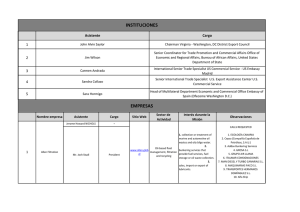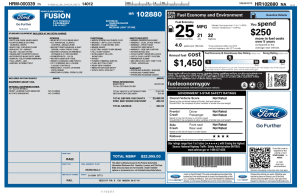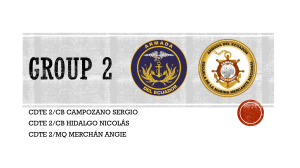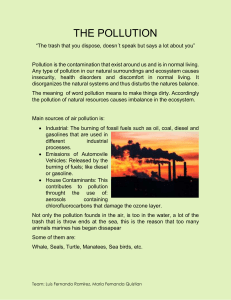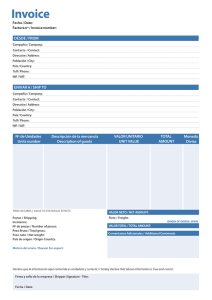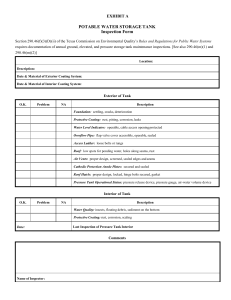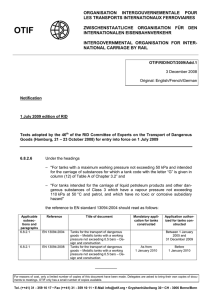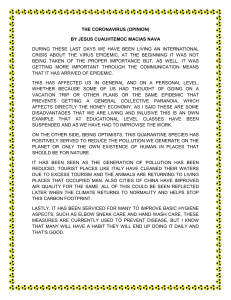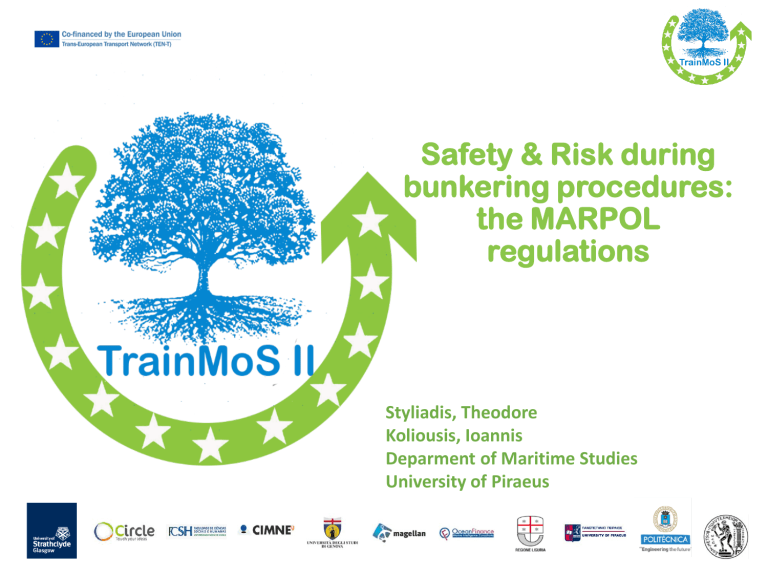
Safety & Risk during bunkering procedures: the MARPOL regulations Styliadis, Theodore Koliousis, Ioannis Deparment of Maritime Studies University of Piraeus Agenda • Definitions • Background • Bunker fuel spills as a primal source of maritime pollution • Bunkering procedures • Additional Issues regarding bunkering procedures and established measures • MARPOL Regulations • Conclusions Definitions • Bunker Barge/Tanker: An authorized bunker barge/tanker supplying bunkers to the receiving vessel. • Bunker Oil: Any hydrocarbon mineral oil including lubricating oil which is carried by a ship and used or intended to be used for the operation or propulsion of that ship and any residues of such oil. • Bunkering Operation: the transfer, between ships or between ship and terminal facility, of a substance consisting wholly or mainly of oil for consumption by the engines of the ship receiving the substance. • Bunker Supplier/Representative: The registered bunker supplier or representative responsible for the delivery and documentation • Berth : Any dock, jetty, quay or place within the Port area where a ship may be secured. • Bunker transfer : Means the transfer of bunker oil, a flammable/combustible liquid intended for the propulsion and or the auxiliary operation of a ship, or a liquid intended for lubrication the ships engine or machinery • Density: is the relationship between mass and volume at a given temperature. Density is important in terms of quantity calculations and correct operation of the purifier; it is also an indicator of the energy and ignition quality of the fuel oil. • Sulphur : is a naturally occurring element in crude oil; it becomes concentrated in the residual heavy fuel during the refining process. The concentration of sulphur in fuel oil depends primarily on the origin of the crude oil. On a worldwide scale the average sulphur level is in the range of 2-4% m/m (by mass). • Blending: is a process for mixing two or more residual fuel oils and/ or distillate fuel oils to achieve a specific end product defined typically by reference to ISO 8217, IFO and viscosity, sulphur content or other parameters. In practice, all bunker fuel is blended at one or more stages of its journey from refinery to ship, occasionally with material that is not suitable for use as bunker fuel; usually but not invariably, such contamination is uncovered by laboratory analysis of delivery sample Agenda • Definitions • Background • Bunker fuel spills as a primal source of maritime pollution • Bunkering procedures • Additional Issues regarding bunkering procedures and established measures • MARPOL Regulations • Conclusions Background • Bunkering, like a number of shipboard activities, carries risk. However, managing the risk and putting the relevant control measures in place will ensure that any operation is carried out in the safest possible manner. • When we talk about safe bunkering practices, we are referring directly to the possibility of uncontrolled spills and the pollution that may result. Most bunkering operations are conducted and completed without any incident, but in a small number of cases something does go wrong. • Frequently we are told that an incident occurred due to excessive pumping rate by the bunker barge, but investigations reveal that the root cause is more often due to poor onboard/onshore practices, and permitting the operation to proceed at an excessive rate. • Also, it is important to remember that careful risk assessment and implementation of effective control measures can, in the event of an overflow occurring, contain the spill on board and prevent, or at least minimize, any environmental impact. • Finally, all bunkering operations should be carefully planned and executed in accordance with applicable regulations. Agenda • Definitions • Background • Bunker fuel spills as a primal source of maritime pollution • Bunkering procedures • Additional Issues regarding bunkering procedures and established measures • MARPOL Regulations • Conclusions Issues for bunkering operations • Due to the relentlessly rising price of oil and its derivatives, along with an everincreasing marine environmental protection awareness, the bunkering of ships, which was once a relatively low skill, low value, activity has evolved into a highly focused shipboard operation in terms of regulatory compliance, quality and quantity assurance • Bunkering operations are governed in general terms internationally by the IMO`s MARPOL Annexes I&VI, while SOLAS Chapter VI Regulation 5.1 also requires that a Material Safety Data Sheet should be provided for oil products carried on board ships. • In addition to the IMO regulations, it is seen that individual states and/or ports have their own regulatory regimes covering bunkering operations. At the same time, many owners have their own specific requirements, instructions and procedures related to such operations, which are laid out in the ship`s Safety Management System (SMS) and the Shipboard Oil Pollution Emergency Plan (SOPEP) • Having said the above, it is unfortunately a fact that oil spills or leakages during bunkering operations are still a major source of oil pollution and such incidents are always followed: • by large penalties, fines and/or imprisonment for those involved • significant cleaning costs for the shipping lines in case of all pollution acts • damages to the environment and the surrounding communities Bunker spills by country Figure 1: Number of bunker spills by country (countries that experienced 110 or more bunker spills between 1992 and 2011) Oil trade routes and tanker spills Frequencies and Quantities of the various types of oil spills(periods 1992-2001 & 2002 -2011) •Spills of crude oil and both persistent and non-persistent refined oil cargos show a reduction in frequency and quantity over the past twenty years. •The number/quantity of crude oil and refined oil cargo spills have more than halved in the period 2002 to 2011 compared to 1992 to 2001 • the bunker spills, however, when comparing the same periods, seem to increase in frequency while the overall quantity of bunker splits despite slightly decreasing over the 2002 to 2011 period ,evolves into the number one polluting factor in terms of quantities spilled. Main Shipboard bunker pollution sources The causes and circumstances of bunker spills from vessels are varied, but can have a significant effect on the maritime environment as well as on the final quantity split. Operations responsible for bunker spills can be classified into the following categories : • Engine room bilges and fuel tanks ballast • Bunker operations • Tankers cargo operations (loading / discharging) • Tank cleaning and ballasting operations on tankers • Unknown operations • Vessel collision/ Tanker accidents • Note: accidental oil spills contribute to less than 5-10% of all oil pollution Bunkering/fueling spills: contributing factors •S Inadequate procedures/ policy Equipment Design Contributing Factors Poor Judgement 20% 23% 4% 5% 13% 6% Malfuntions Procedural Violations Poor Overisght Inattention 7% 11% 11% Inexperience Other pillages and leakages during bunkering operations are a primary source of oil pollution from ships. •Many spills are the result of carelessness or negligence, either on the part of those supplying the bunkers, or those on board the vessel receiving them. Even a technical problem, such as the failure of an alarm to go off, may well be the result of human error. • Experience has shown that many of the bunker overflows and spillages that do occur are in fact attributed to human error. Bunker spills causes More often, according to literature one or more of the following are present in a bunker oil spill: • failure to agree a loading rate with the bunker barge or shore loading facility; • failure on the part of the bunker barge or shore facility provider to stick to the agreed loading rate; • failure on the part of the vessel’s crew to check that the bunkers are being loaded at the agreed rate and if they are not, failure to request the loading barge to slow down; • failure to monitor the tank(s) into which the bunkers are being loaded; • failure to respond to an alarm indicating that the tank is nearly full. • Out of all of these, experience has shown that most bunker spills result from an overflow of bunkers. Agenda • Definitions • Background • Bunker fuel spills as a primal source of maritime pollution • Bunkering procedures • Additional Issues regarding bunkering procedures and established measures • MARPOL Regulations • Conclusions Bunker planning • Due to all the above spillages causes, bunkering operations should be carefully planned and executed in accordance with MARPOL regulations. Pollution caused when heavy bunker oil is split is particularly damaging and difficult to clean-up. Ships' bunkers normally consist of heavy fuel oils, which in general are highly viscous and persistent and therefore a relatively small quantity of highly persistent bunker fuel, can be disproportionately damaging and costly to remove in comparison. • Therefore, it is important to understand and organize every step of the operation while being pro-active in the management, is essential. • Personnel involved in the bunkering operation on board should have no other tasks and should remain at their workstations during topping-off. This is particularly important when bunkers are being loaded concurrent with cargo operations, in order to avoid conflicts of interest for operational personnel. Spillages often occur when staff are distracted by another task. • It is necessary that a bunker plan is produced, which should be detailed and carefully considered. The procedures should ensure that the risks associated with the operation have been assessed and that controls are in place to mitigate these risks. The procedures should also address contingency arrangements in the event of a spill Bunker planning (cont.) • A good bunker plan should include: – an accurate summary of the different quantities and grades of fuel to be supplied – a plan of which bunker tanks are to be filled, which must include the type and quantity assigned to each tank and the maximum filling volumes – a schematic diagram of the bunker system and proper valve line-up – the filling sequence and the required pumping rate, including initial, maximum and topping off rate – an indication of the safety margin or ‘slack’ space to be left in each tank. For example, no tank is to be more than 90% full – soundings of each tank prior to commencement of bunkering and the expected soundings/ullages on completion – the method of sounding and or ullaging, which can be stipulated to avoid confusion – details of who is in overall charge of the operation, this is usually the chief engineer and it should also indicate who else is involved and their respective duties – emergency procedures and contacts -- testing of High level alarms setting in the fuel oil tanks or a substitute means incase alarms are not provided – proper identification and markings of the valves on the bunker lines – procedure for changing over tanks during the bunkering – vessel stability drafts, trim and list during the various stages of bunkering – manning requirements to execute the operation safely. The chief engineer should formalize the bunker plan by holding a ‘toolbox talk’ with Deck and Engineering department personnel involved. The plan should be discussed and confirmation sought that all of the team fully understand the contents and their role in the operation. The meeting should also review the bunker checklist and risk assessment to ensure that all the identified controls are in place. Operations should only be undertaken by personnel familiar with the ship’s bunker system and procedures. Newly joined personnel or those not familiar with all aspects of the operation should be accompanied as part of on-going training and familiarization. Division of responsibilities • Before bunkering procedures initiate ,operating instructions and responsibilities (in relations to bunkering operations) should be divided and delegated among personnel: • Master: responsible for the supervision of the bunkering system and checking the bunker plan • Chief Officer: responsible for deploying the pollution prevention equipment • 2nd & 3rd Officers: responsible for monitoring bunker operations as instructed by the Chief Officer and ensuring that a proper watch is maintained • Chief Engineer: responsible for equipment maintenance and advising the Chief Officer on the bunker transfer procedure. • Deck Watch: the person stationed by the hose connection in order to check for kinking, chafing or leakage • Pump man and Ratings: responsible for bunker operations assistance as required by the Chief Officer. • There are examples of incidents occurring due to bad responsibility allocation or where the Chief Officer had delegated various responsible task to rating instead of the deck officer. • For this reason efficient allocation of responsibilities among the crew is an important prerequisite to ensure the secure and incident free bunker procedures Completion of the bunkering planning Notification Form • The bunkering notification form allows an applicant to inform the harbormaster of the intended works to be undergone. • All sections of the form must be completed. 1) Notice From. This should contain the name of the applicant and the company they work for. The date and time of submitting the notification and contact phone numbers. 2) Statement of Work to be done. This should contain full details of the vessel name, location at the time the work will be carried out, date and time it is intended to carry out the work and a description of the intended work. 3) Risk Assessment. All of the questions in this section must be answered. 4) Precautions to be in place. A full description of precautions that will be in place should be noted. Bunkering Operations Notification, on Receipt Procedure • On receipt of a bunkering operations notification, the Harbormasters Office should: 1) Check that the form is correctly completed and the provisions stated are adequate for the operation being carried out. If not then contact applicant and forbid bunkering operation until the form is completed correctly and provisions stated are adequate. 2) Enter the details in the Bunkering Operations Notification Log, at the front of the Bunkering Notification file. 3) If the work requires an audit, visit the site and complete an audit (Audit form in Bunkering Notification file). 4) Determine if there is any other reason the bunkering operation should not go ahead? If yes, then contact the applicant and forbid the Bunkering Operation, investigate. 5) Use the Bunkering Procedures Risk Matrix to establish whether a Barge should be launched. 6) Launch Barge if required. Check-lists • Once the bunker planning procedure is produced and the bunkering notification note has been accepted by the harbormaster, operations can commence, however they should be implemented in accordance of a check-list. • Checklists are an essential and useful tool for safe operations and if used correctly they will help to prevent an incident. • For this reason the on behalf of both parties before the commencement of bunkering operations specific issues should amongst others: • Agree in writing the handling procedures, including the maximum transfer rates. • Agree in writing the action to be taken in the event of an emergency during transfer operations. • Complete and sign the Bunkering Safety Check-List. • The Bunkering Safety Check-List is based upon the Ship/Shore Safety Check-List (see Section 26.3) and the Pre-Transfer Bunkering Check-List contained in the IMO publication ‘Recommendations on the Safe Transport of Dangerous Cargoes and Related Activities in Port Areas’. The Check-List is primarily structured for loading bunkers from a barge, but it is also suitable for use when taking bunkers from a tank or a jetty. Check-lists (cont.) • The Bunkering Safety Check-List uses statements assigning responsibility and accountability. Ticking or initialling the appropriate box, and finally signing the declaration, confirms the acceptance of obligations. Once signed, this provides the minimum basis for safe operations as agreed through a mutual exchange of critical information. • Some of the Check-List statements are directed to considerations for which the ship has sole responsibility and accountability, some for which the bunker provider has sole responsibility and accountability and others which assign joint responsibility and accountability. Shaded boxes are used to identify statements that generally may be applicable to only one party, although the ship or provider may tick or initial such sections if they wish so. The assignment of responsibility and accountability does not mean that the other party is excluded from carrying out checks in order to confirm compliance. • The assignment of responsibility and accountability ensures clear identification of the party responsible for initial and continued compliance throughout the transfer activity. • The Responsible Officers completing the Check-List should be the people carrying out the bunkering operation. • The vessels Responsible Officers should personally check all considerations lying within the responsibility of the vessel. Similarly, the providers Responsible Officer should personally check all considerations that are within their responsibility. In fulfilling their responsibilities, Responsible Officers should assure themselves that the standards of safety on both sides of the operation are fully acceptable. Bunkering Safety Check-List • The Bunkering Safety Check-List contains the following sections : 1. Bunkers to be Transferred: A joint agreement on the quantity and grades of bunkers to be transferred, together with agreed transfer rates and the maximum line back pressures. 2. Bunker Tanks to be loaded: An identification of the tanks to be loaded with the aim of ensuring that there is sufficient space to safely accommodate the bunkers to be transferred. Space is provided to record the each tank’s maximum filling capacity and the available volume. 3. Checks by Barge Prior to Berthing: This section provides the checks to be carried out before the barge goes alongside the ship 4. Checks Prior to Transfer: This section provides the checks to be jointly undertaken before transfer activities commence. Bunkering Safety Check-List • The safety of operations requires that all relevant statements are considered and the associated responsibility and accountability for compliance accepted. Where either party is not prepared to accept an assigned accountability, a comment must be made in the Remarks column and due consideration given to whether operations should proceed. • Where an item is agreed not to be not applicable to the ship, to the provider or to the operation envisaged, a note to that effect should be entered in the `Remarks’ column. • The presence of the letters ‘A’ or ‘R’ in the Code column indicates the following: • A (‘Agreement’). This indicates an agreement or procedure that should be identified in the Check-List or communicated in some other mutually acceptable form. • R (‘Re-check’). This indicates items to be re-checked at appropriate intervals, as agreed between both parties and stated in the declaration. The joint declaration should not be signed until all parties have checked and accepted their assigned responsibilities and accountabilities. Bunkering operations • Once bunkering procedure is about to commence: • Person in charge on ship to advise person in the facility that operations are about to begin • Valves and lines must be set by nominated person and then doublechecked by the designated person in charge • Valves not used for the operation should remain closed and blankets manifold connections should be checked for tightness • Operations should commence slowly and checks should be undertaken to ensure bunkers going into the correct tanks before increasing the rate • Everyone must follow the plan. If something changes: • • • • • Stop the bunkering Adjust the plan Communicate the plan changes to everyone Post the new plan at the point-of-transfer Resume bunkering under the new plan During bunkering operations • The following basic principles of bunkering must accomplished between the involved parties in order to reduce exposure to associated losses and risks: • Keep regular communications: • • • • • During transfer operations there should be regular communication maintained between the vessel and supplier. Once the method of communication is initially established, the following information should be exchanged: Confirm transfer starting and stopping procedures Confirm transfer rates, pressures and quantities Confirm emergency stop procedures Confirm method of raising the alarm in the event of an emergency • Keep rate safe and within agreed limits: • • • Compare deliverer’s rate to receiving rate If the bunker transfer rate exceeds the planned rate, the provider should notify the receiving vessel’s Chief Officer to decrease the transfer rate Allow ample time to complete the operation at a safe transfer rate when scheduling the bunkering operation. Time constraints should not drive the need for an increased transfer rate. • Check rate by taking regular soundings: • • • Sound fuel tanks at regular intervals that fit the bunker operation and the stage of bunkering taking place (for example: starting, steady flow, and topping-off).The soundings should be recorded and sounding records kept in the bunkering file Verify, by frequent observations, that all fuel system tank levels are as expected. If using the ship’s electronic tank gauging system during the bunkering operation, verify the electronic system is accurate with manual soundings during bunkering. Calculate and record transfer rates based on soundings, and keep them in the bunkering file • Make frequent checks of connections and for leaks • Shut down if: • • • • • Fire at or near the ship Local weather conditions are not suitable Sea conditions are not suitable Burst of pipe or overflow Any unexpected soundings or level alarms Emergency Procedures • Procedures for handling all emergencies may vary but should include as a minimum: • Method of raising the alarm • Responsibilities of key personnel • Action taken by employees to ensure their own safety and the safety of those around them • Action taken by employees to minimize the damage to property and environment • Method of cleaning up a spill • Method of informing Port Control, government agencies, owners, charterers and their agents • All ships involved in bunker transfers should maintain on board sufficient oil spill response equipment to respond effectively to the potential size of spill that could occur during bunkering operations. An adequate number of personnel to assist in deployment of emergency equipment must also be available during the bunker transfer. Completion of bunkering operations • After the completion of bunkering operations the designated person in charge must check and perform personally: • All tank valves are closed and vents operational • All openings are closed and tight to protect against entry of sea water • The pipelines and hoses between the ship and the bunker facility have been cleared • Sufficient ullage space is available before draining lines to ship’s tanks before disconnecting hoses • Drain cock to be opened and drained • Manifold blanks are securely fitted after disconnection • Take final soundings of all fuel oil tanks to ensure ample space for expansion. • Properly complete oil record book, deck, and engine log books. • Save the written pre-loading plan and declaration of inspection for at least 30 days. Agenda • Definitions • Background • Bunker fuel spills as a primal source of maritime pollution • Bunkering procedures • Additional Issues regarding bunkering procedures and established measures • MARPOL Regulations • Conclusions Health, Safety, Environmental protection SOLAS Chapter VI Regulation 5-1 requires that a Material Safety Data Sheet (MSDS) for MARPOL Annex I type Cargoes and Marine Fuel Oils shall be provided to the ship by the supplier prior to loading or bunkering; this is to assist shipboard personnel in carrying out their duties under safe conditions. MSDSs might include the following warnings and guidance: Bunker Fuel and vapors may: • Ignite • Cause dizziness and headaches • Contain hydrogen sulphide which is highly poisonous • Harm or cause irritation to skin • Irritate the mouth and lungs Precautions: • Never enter an enclosed space not approved as safe for entry • Stand to windward when opening tank lids or sampling points • Use goggles • Wear suitable gloves • Wear suitable working protective clothing • Change out of any oil-soaked clothing as soon as possible Fire Precautions: • Keep all bunker fuel away from naked flames, sparks or other sources of ignition • Keep all bunker fuel away from heated surfaces Operations • Do not smoke on deck during bunkering operations • Do not smoke near fuel tanks, or other locations where fuel vapors may be given off Safety and Environmental Protection • The Chief Officer and the delegated personnel should know and use the appropriate Safety Management System checklists and procedures for bunkering, and if applicable, for Ship to Ship operations • The Chief Officer and the delegated personnel should know the ship’s Shipboard Oil Pollution Emergency Plan (SOPEP) or Shipboard Marine Pollution Emergency Plan (SMPEP) • Ship’s oil spill equipment should be ready and available in accordance with the SOPEP/SMPEP • It must be ensured that proper lines and means of communication internally and externally are established prior to commencing operations, including particularly agreement on how ship stop or supplier stop instructions will be given, acknowledged and implemented • Any spill in connection with a bunkering operation must immediately and in accordance with the SOPEP/SMPEP be reported to the appropriate bodies, including but not limited to: • Port Authorities • Port State Authorities • Owners/Operators/Managers • Ship’s P&I Club • Oil Spill Contractors/Qualified Individuals, if applicable o Ship’s Flag State Record keeping • All events and bunkering operations are to be carefully entered in both the Deck and Engine log books respectively and checks should also be made in order to ensure that the appropriate entries in the Engine Room Oil Record Book are also made. • Events that should be entered in the records include: • Bunker system maintenance and testing • Pre-arrival checklist • Bunker loading plan • Bunker start-up and completion times • Sounding/ullage records • Bunker measurement calculations • Bunker tank gas readings • Compliance with SMS, SSP, inclusive procedures and best practices • Completed bunker checklists • Record book entries (deck, engine and scrap log books) • Oil record books • All bunker-related communications and exchange of documents including: • • • • • • • Bunker Delivery Note (BDN) Letters of Protest Fact Sheets Sounding reports and measurement calculations sheets Bunker Quality certificates Bunker receipts Sample distribution and records should be carefully completed, checked, forwarded and filed as appropriate. Surveys • Procedures in ports which are in a state which is party to MARPOL Annex VI obliges the suppliers to undergo a sampling procedure . • The sampling procedure should be in accordance with that detailed below: • A continuous drip sample is to be taken throughout bunkering at the closest available sampling point to the receiving ship’s bunkering connection/manifold agreed between the supplier’s and receiver’s representatives • The sampling procedures include: • the sampling equipment, including a sampling container, to be checked for proper cleanliness and operation. • prior to commencement of bunkering, proper sealing of sampling container and needle valve are to be agreed upon and properly recorded. • sampling is to start simultaneously with the bunkering; if necessary, the needle valve must be adjusted to produce appropriate sample flow. • if the sampling container is changed during bunkering, the new sampling container and needle valve must be re-sealed; all sample seal numbers must be recorded. • Continuous checks of the sampling container and needle valve seals are to be carried out. • After completion of bunkering, both the supplier’s and receiver’s representatives are to verify and witness the condition of the seals before breaking the seals. • The sampling container is to be shaken in order to promote homogeneity of the sample. • The sample is to be poured into 4 or 5 sample containers. • Sample containers are to be sealed with uniquely-numbered seals and checked against those seals. • Both the supplier’s and receiver’s representatives are to sign the sample labels. • All seal numbers are to be recorded on the sample labels and in the Bunker Delivery Note (BDN). • The BDN is to be signed and countersigned by the supplier’s and receiver’s representatives respectively. • Finally, It is important to remember that in the event of a dispute the samples may be required as evidence in a court of law. Surveys - Minimum information for a Sample label The Sample label should include information with regards to: • Name and IMO number of the receiving ship • Place or port of bunkering • Name of bunker supplier • Name of bunker carrier (barge, tanker, truck or installation) • Grade of bunker fuel • Date and time delivery commenced • Sample method used to obtain representative sample • Location at which sample was drawn • Name and signature of the supplier's & receiver’s representative • Seal number (and also cross-checked with Bunker Delivery Note) Surveys- cautions • Parties with regards to surveys and samples should be cautious with regards to: • not signing any sample seals or labels prior to completion of the bunkering • not signing extra seals or sample labels • not signing any received samples without witnessing the origin of them • Always re-check the condition of seals and record seal numbers prior to signing the BDN • If the receiving ship is only provided with samples of unknown origin and/or samples which have not been witnessed, such samples and associated documents should be stamped and/or marked and/or signed “sample origin unknown, signed without prejudice to acknowledge receipt only” and a letter of protest issued to that effect. • samples given to the vessel should be stored in a safe place and retained for a period (usually at least 3 months) before safe disposal. Individual vessel operators may require the samples to be retained for a longer period • requirements for the MARPOL sample are more stringent, these must be retained for a period of 1 year, either on board the vessel or at a location which is “under the ships control” Testing of the bunkers • It is common to have the supplied bunkers tested by an appropriate laboratory before use on board in order to be confident that the bunkers are within the agreed specifications and do not contain any substances that might diminish performance, increase wear and tear of the ship’s engines or otherwise cause harm. • Laboratory testing is also used to ensure compliance in MARPOL Annex VI’s Emission Control Areas and with local regulations requiring the use of low sulphur fuels. It is recommended that any indication of sulphur levels above 4.5 % or 1.0 % respectively should initiate a notification to the flag administration, bunker port administration and supplier according to the requirements of the IMO Port State Control Guidelines for MARPOL Annex VI as set out below: • The Port State Control Officer (PSCO) should check whether the quality of fuel oil used on board the ship conforms to the provisions of MARPOL Annex VI regulations 14 and 18*, taking into account appendix IV to the Annex. Furthermore, the PSCO should pay attention to the record required in regulation 14(6) in order to identify the sulphur content of fuel oil used while the ship is within SOx emission control areas, or that other equivalent approved means have been applied as required. • *It should be noted that in the case where the bunker delivery note or representative sample as required by regulation VI/18 is not in compliance with the relevant requirements, the master or crew should have documented that fact. Where fuel oil supply was undertaken in a port under the jurisdiction of a Party to MARPOL Annex VI, the PSCO should report that non-compliance to the appropriate authority responsible for the registration of fuel oil suppliers in accordance with regulation Testing- measurements & quality • If possible, both the supplying ship’s and receiving ship’s designated fuel tanks for the bunkering operation should be measured and surveyed before commencement in order for supplier’s and receiver’s representatives to agree upon the content and condition of the these tanks. • If there is any disagreement related to the quantity, this should form a basis for issuing a letter of protest but it should be noted that suppliers’ terms and conditions generally specifically disallow shipboard measurement in connection with any dispute as to the quantity delivered. Testing: Be aware Receiving ship's crew should be alert and aware to the following malpractices observed such as: • Shortening or lengthening of measuring tapes used by the supplier • Falsified tank tables for the supplying tank or tanks • Deliberately declaring incorrect densities and temperatures of the delivered fuel or fuels • Adding water; for example by using the supplying barge’s fire-pumps or other service-pumps • The so-called “cappuccino effect”: This effect has reportedly been a trend in Singapore, whereby the delivery bunker tank contains excessive amount of air, resulting in the quantity of fuel delivered and received being significantly overstated. This effect is termed “Cappuccino” as the entrained air causes the fuel to “foam” which makes traditional manual measurement at the time of delivery unreliable. Subsequently, the foam tends to settle and tank measurements show a significant loss of fuel • Other less sophisticated methods of reducing the quantity of bunker fuel delivered include unauthorized or concealed piping between the storage tanks and other un-nominated tanks, such as coffer dams or void spaces. Agenda • Definitions • Background • Bunker fuel spills as a primal source of maritime pollution • Bunkering procedures • Additional Issues regarding bunkering procedures and established measures • MARPOL Regulations • Conclusions MARPOL Regulations • The MARPOL 73/78 Convention is the main international Convention covering prevention of pollution of the marine environment by ships from operational or accidental causes. • It is a combination of two treaties adopted in 1973 and 1978 respectively and updated by amendments through the years. Now there are six Annexes, each dealing with a different type of ship-sourced marine pollution. Thus, it does not only deal with oil, which is regulated in Annex I but with all forms of marine pollution from shipping activities. • The Convention includes regulations for control and prevention of pollution by hazardous and noxious liquid substances in bulk (Annex II), harmful substances carried by the sea in packaged form (Annex III), sewage pollution from ships (Annex IV), garbage pollution from ships (Annex V), as well as air pollution from ships (Annex VI). The first two of the annexes need to be accepted by the parties to the Convention, but the other annexes are voluntary MARPOL Annex I • As mentioned above, Annex I covers the prevention and reduction of oil pollution from operational as well as from accidental oceanic oil discharges. • Under the terms of Annex I, all ships are subject to surveys to guarantee that the structure, equipment, materials and arrangements thoroughly comply with the Convention. • The Convention regulates the conditions when and where oil discharges from tankers are allowed. However, the amounts of oil and oily mixtures which can be discharged of the cargo into the sea were reduced. • Furthermore, under MARPOL it is strictly forbidden to discharge in special areas including the Black Sea, the Baltic Sea, the Mediterranean Sea and the Persian Gulf • To ensure the effectiveness of these stringent discharge regulations, specific equipment such as oil-discharge monitoring systems, pumping arrangements and slop tanks are required aboard. • In addition, governments have to install reception facilities for oily waste water and all new tankers have to be equipped with double hulls. It is compulsory for new tankers over 70.000 dwt to have segregated ballast tanks so it is no longer possible to use the same volume for ballast and cargo and to fulfill damage stability requirements. • Moreover, MARPOL provides an oil record book requirement, where the movement of cargo oil and its residues has to be recorded. These book entries can be freely inspected by any member states at any time. MARPOL Annex VI • Marpol’s Annex VI is targeted towards the Prevention of Air Pollution from Ships (entered into force 19 May 2005 and the revised Annex VI on 1 July 2010) • sets limits on sulphur oxide and nitrogen oxide emissions from ship exhausts as well as particulate matter and prohibits deliberate emissions of ozone depleting substances, such as hydrochlorofluorocarbons. • More stringent standards are set for Emission Control Areas designated by IMO (Baltic Sea, North Sea and North America). Further information on the control of the above emissions, is given by the targets set by Annex VI: • The MARPOL Annex VI sulphur limits and application dates are as follows: • 1 July 2010 – Sulphur cap in Emission Control Area’s (ECA’s) reduced from 1.50% to 1.00% • 1 January 2012 – Global sulphur cap to be reduced from 4.50% to 3.50% • 1 January 2015 – Sulphur cap within ECA’s to be reduced to 0.10% • 1 January 2020 – Global sulphur cap to be reduced to 0.50% MARPOL’s weaknesses & strengths • Nowadays nearly 98% of the world’s merchant tonnage is registered to, have accepted and become parties to the MARPOL Convention. • All vessels flagged under countries that signed the Convention are subject to its requirements, irrespective of where they sail or operate, and member states are responsible for ships registered under their respective nationalities. • After a state signed the Convention, it is that state’s responsibility to create and enact national legislation which will implement the regulations set out in the convention. • Pursuant to IMO, MARPOL is “the most ambitious international treaty covering maritime pollution ever adopted”. Since its adoption, a decrease in the amount of oil entering the sea from vessels can be seen. • Although the convention as an international regime scored a great success, there are still a few weaknesses, which have to be mentioned. MARPOL is not always effective, because there are some Member States which do not make this convention part of their domestic law due to the lack of experience, resources and know-how MARPOL’s implementation • Although the IMO is the institution, which is responsible for the existence of most of the international conventions concerning ship-sourced oil pollution, it is not empowered to implement and enforce these conventions. • It is the flag, port and coastal states, which are vested with the power of implementation and enforcement of these conventions. • At the beginning, however, only the flag states were able to enforce IMO conventions. After several flag states did not comply with their duties due to the lack of incentive, it led to a reduction in the effectiveness of the Convention. • As a result, especially with the adoption of MARPOL, the jurisdiction of coastal and port states has improved and these states have been entrusted with some enforcement powers. • Furthermore, no sanctions will be imposed on flag states, which do not fulfill their MARPOL responsibilities. • That is why the states do not take these imposed responsibilities too seriously. In the United States, as an example, the relevant implementation legislation is the Act to Prevent Pollution from Ships (APPS) while in Europe, MARPOL 73/78 is implemented in European Law by the EU Ship Source Pollution Directive Agenda • Definitions • Background • Bunker fuel spills as a primal source of maritime pollution • Bunkering procedures • Additional Issues regarding bunkering procedures and established measures • MARPOL Regulations • Conclusions Summary and Conclusion • To reduce the possibility of a spill occurring, or to minimize the effects of any spill, it is important to: • always ensure sufficient people familiar with the bunkering system and operation are allocated to the ship’s team. Insufficient personnel have been the cause of numerous spills particularly when topping off tanks • always start the bunkering operation at a low pumping rate. Once the system has been checked for leaks and free-flow, the rate can be increased to the agreed pumping rate. When checking for leaks always remember to include the opposite manifold that is not being used. Check all bunker tanks to ensure that the fuel is only being received into the correct tanks • continuously monitor tank levels, including tanks not in-use and remember to keep to the agreed tank capacity safety margin • keep accurate and regular records to monitor pumping rates and check gauges to ensure that line pressures are not too high • make regular checks on the bunker overflow tank sight glass and tank level • continuously check primary and back up communication methods • make regular checks on the mooring arrangement. Keep a ‘good eye’ on passing traffic Summary and Conclusion • make regular inspections of the manifold and hose. The operation must halt if any small drips are seen and the leak be rectified immediately • make regular inspections of the bunker tank sounding pipes and relevant vents. Remember to close and cap sounding pipes at all times, when not in use • change over tanks in a timely manner and allow enough ullage space in tanks to verify valve positions. Remember always open the next designated tank valve first before shutti ng the current tank valve • remember to monitor tanks that are completed and to double check that valves are properly closed. Consider visually inspecting remotely operated valves to verify their open and closed positions when ‘toppingoff’ tanks, inform the bunkering facility and reduce the pumping rate. Remember to maintain the tank capacity safety margin at all times • drain off rain or other water accumulated on deck to keep the scuppers dry and prevent the free flow of oil over board in the event of a spill – keep watch handovers to a minimum and, if they are necessary, they should be detailed, accurate and fully informative of the on-going operation • remember to manage the operation in conjunction with the barge. Do not allow the barge to dictate how the operation is managed • make sure that the MARPOL drip sample is functioning correctly and the relevant samples are drawn. Double check the delivered temperature and carry out compatibility tests, where required • stay alert throughout the full bunkering operation and investigate changes or discrepancies immediately. If in doubt do not hesitate to suspend the operation. End of Session Thank you for your attention! Q&A
